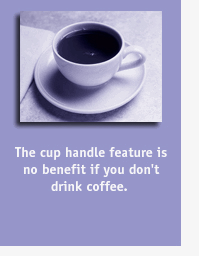
Features, Benefits, and Solutions
| Продажи | ||||
| Sales.com | ||||
| Providing... | ||||
by Graham Denton
A solution is, by definition, the resolution of a problem. If you don't have a problem, you don't need a solution. Elementary? Sure, but it's amazing how often it's forgotten by salespeople intent on pushing their products. Major sales are lost every day by amateurish attempts to resolve nonexistent problems.
 Actually,
a better word than nonexistent would be unperceived. When a salesperson's
solution fails to connect with a customer, it's usually because that customer
has not perceived that he or she has a problem, and therefore feels no
urgency about "resolving" it. This is true, of course, even when the problem
is blatantly obvious to the salesperson, and it's why they so often are
frustrated in attempting to demonstrate to prospects that their perceptions
are wrong and they're actually in trouble. Think of how difficult it is
to sell life insurance to people in their twenties: If you're still convinced
of your own immortality, what problem is there to solve?
Actually,
a better word than nonexistent would be unperceived. When a salesperson's
solution fails to connect with a customer, it's usually because that customer
has not perceived that he or she has a problem, and therefore feels no
urgency about "resolving" it. This is true, of course, even when the problem
is blatantly obvious to the salesperson, and it's why they so often are
frustrated in attempting to demonstrate to prospects that their perceptions
are wrong and they're actually in trouble. Think of how difficult it is
to sell life insurance to people in their twenties: If you're still convinced
of your own immortality, what problem is there to solve?
The unperceived issue is related to the old distinction between features and benefits. In order to sell a feature, you've got to show it has a benefit, that it has some value to the prospect or customer. No value, no benefit, no sale. Pushing a feature on a customer for whom it has no benefit is equivalent to pushing a solution for an unperceived problem.
In his book Solution Selling, Michael T. Bosworth adds a useful nuance to this old distinction by introducing an intermediary term: advantage. If a feature is something that exists in the product or service itself and a benefit is the value that a customer sees in that feature, an advantage is the feature's potential value -- an inherent value that may or may not be seen as such by a given customer.
Bosworth gives the example of a coffee cup. The handle of the cup is an existing feature. Its advantage is that it enables you to drink coffee without burning your fingers. Its benefit is that it prevents something you had wanted to avoid; it anticipates and provides a solution to a potential problem. But the handle is only a benefit to a coffee fancier. If you don't drink coffee (or some other hot drink), the handle feature is merely an advantage, not a benefit.
For a more sophisticated example, consider the caller ID feature than many telecommunications companies now offer their customers. It's certainly an advantage in that it enables customers who want to screen their callers. Is it a benefit? Only to customers who perceive value in that advantage. Is it a solution? Only to customers who believe that they have a problem -- in this case, a surplus of incoming calls that they don't want to deal with. If you're not bothered by such calls, if the tracing potential of this technology makes you uneasy, or if for any other reason you don't see a problem in unscreened calls, then by definition this feature has no benefit for you, and the salesperson who provides you this "solution" probably will get nowhere.
Effective selling always starts in the customer's mind, with some discrepancy to be resolved or some problem overcome. If the customer perceives there's no problem, you've got no solution.